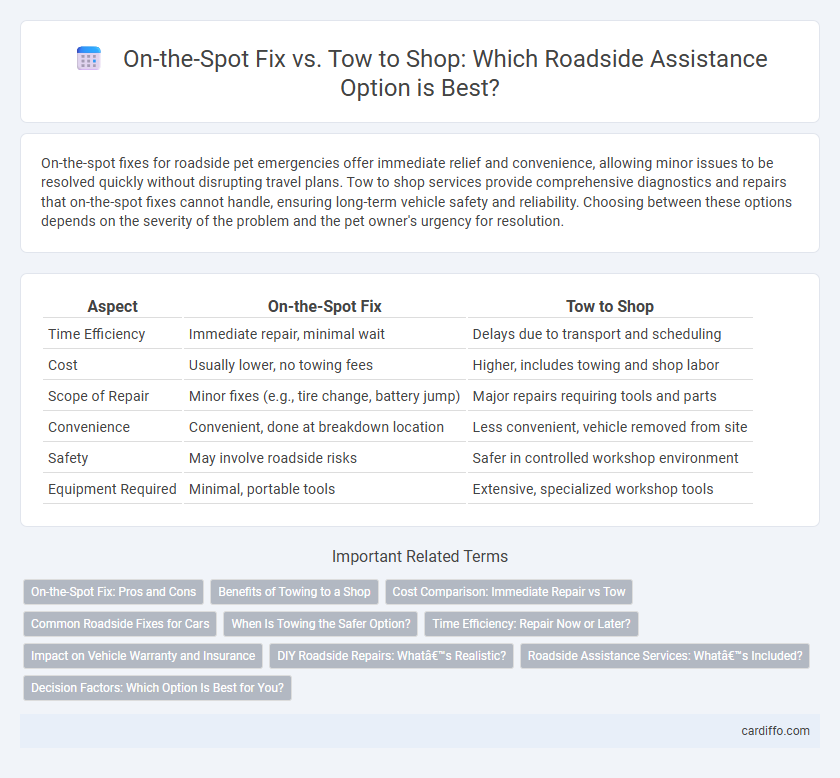On-the-spot fixes for roadside pet emergencies offer immediate relief and convenience, allowing minor issues to be resolved quickly without disrupting travel plans. Tow to shop services provide comprehensive diagnostics and repairs that on-the-spot fixes cannot handle, ensuring long-term vehicle safety and reliability. Choosing between these options depends on the severity of the problem and the pet owner's urgency for resolution.
Table of Comparison
| Aspect | On-the-Spot Fix | Tow to Shop |
|---|---|---|
| Time Efficiency | Immediate repair, minimal wait | Delays due to transport and scheduling |
| Cost | Usually lower, no towing fees | Higher, includes towing and shop labor |
| Scope of Repair | Minor fixes (e.g., tire change, battery jump) | Major repairs requiring tools and parts |
| Convenience | Convenient, done at breakdown location | Less convenient, vehicle removed from site |
| Safety | May involve roadside risks | Safer in controlled workshop environment |
| Equipment Required | Minimal, portable tools | Extensive, specialized workshop tools |
On-the-Spot Fix: Pros and Cons
On-the-spot fix offers immediate vehicle repair at the roadside, reducing wait times and minimizing inconvenience for drivers. It is cost-effective for minor issues like tire changes or battery jumps but may lack the comprehensive diagnostic tools available in a shop setting. However, complex repairs requiring specialized equipment or parts often necessitate towing to a professional garage for lasting solutions.
Benefits of Towing to a Shop
Towing a vehicle to a professional shop ensures access to advanced diagnostic tools and specialized technicians, resulting in a more accurate and lasting repair. Shops can provide comprehensive services, including part replacements and warranty options, which are often unavailable during on-the-spot fixes. This approach minimizes the risk of incomplete repairs and ensures vehicle safety and reliability for long-term use.
Cost Comparison: Immediate Repair vs Tow
On-the-spot fixes typically cost less than towing because labor and parts are used only for immediate repairs, avoiding tow fees and extended service charges. Towing to a shop incurs additional costs including tow fees, shop diagnostics, and potentially higher labor charges for comprehensive repairs. Choosing immediate roadside repairs minimizes total expenses when problems are simple and can be resolved quickly.
Common Roadside Fixes for Cars
Common roadside fixes for cars include tire changes, battery jump-starts, and minor fluid top-offs, which can be resolved quickly on the spot without requiring a tow. Flat tires are often addressed by replacing the damaged tire with a spare, while battery jump-starts restore power to enable immediate travel. For issues such as engine overheating or severe mechanical failures, towing to a repair shop remains the safest and most effective option.
When Is Towing the Safer Option?
Towing is the safer option when a vehicle experiences severe mechanical failure, compromised steering or braking systems, or hazardous road conditions that make driving unsafe. Emergency responders and roadside assistance professionals often recommend towing to prevent further damage and ensure the safety of the driver and passengers. Choosing towing over on-the-spot fixes is critical when the vehicle's issue requires specialized equipment or extensive repairs unavailable at the roadside.
Time Efficiency: Repair Now or Later?
Choosing an on-the-spot fix at the roadside maximizes time efficiency by addressing minor vehicle issues immediately, reducing wait times and avoiding the need for towing. Tow to shop options may involve longer delays due to transit and repair scheduling but allow for comprehensive diagnostics and repairs. Prioritizing on-site repairs saves critical time when the problem is minor, whereas towing is preferable for complex or unsafe conditions requiring professional equipment.
Impact on Vehicle Warranty and Insurance
On-the-spot fixes often preserve vehicle warranties by addressing minor issues without involving a repair shop, minimizing the risk of warranty voidance. Insurance policies may favor immediate repairs to reduce claim costs and avoid extensive damage assessments. Towing to a shop, while sometimes necessary, can trigger detailed inspections that might complicate warranty claims and lead to higher insurance scrutiny.
DIY Roadside Repairs: What’s Realistic?
DIY roadside repairs often include changing a flat tire, jump-starting a battery, or replacing a blown fuse, which are manageable with basic tools and knowledge. Complex issues like engine troubles or suspension damage typically require professional attention, making towing to a shop the safer and more effective option. Understanding the limits of on-the-spot fixes can prevent further damage and ensure timely, cost-effective vehicle recovery.
Roadside Assistance Services: What’s Included?
Roadside assistance services typically include on-the-spot fixes such as jump-starts, flat tire changes, and minor mechanical repairs, allowing drivers to quickly resume their journey without needing a tow. When on-the-spot repairs are not feasible, towing to a nearby shop ensures the vehicle receives comprehensive diagnostics and repairs by professional mechanics. Both options prioritize minimizing downtime, with service plans often specifying coverage limits, response times, and which repairs qualify for immediate roadside intervention versus towing.
Decision Factors: Which Option Is Best for You?
Choosing between an on-the-spot fix and towing to a shop depends primarily on the severity of the vehicle issue and availability of mobile repair services. Minor problems like flat tires or battery jump-starts are often resolved quickly on-site, minimizing downtime and expense. Complex mechanical failures require towing to a professional workshop equipped with diagnostic tools and parts to ensure thorough and safe repairs.
On-the-Spot Fix vs Tow to Shop Infographic

 cardiffo.com
cardiffo.com